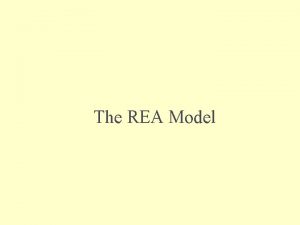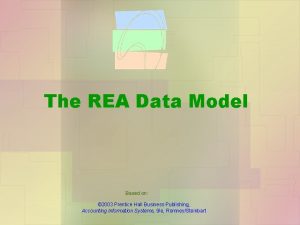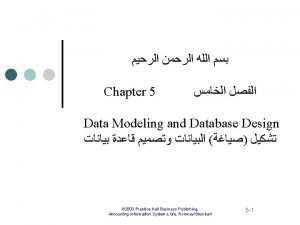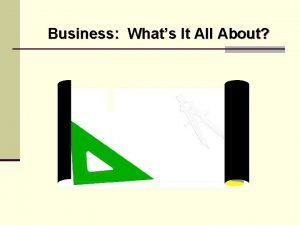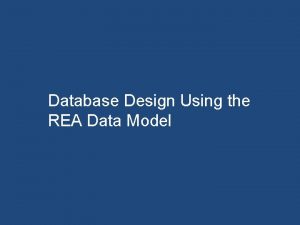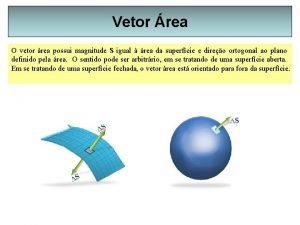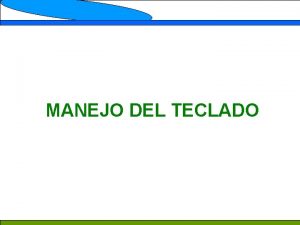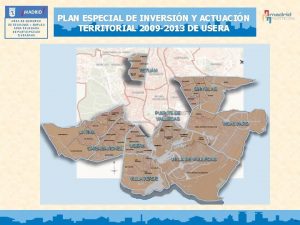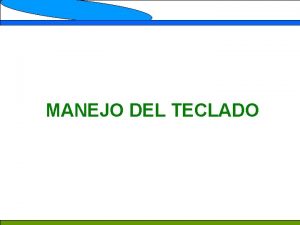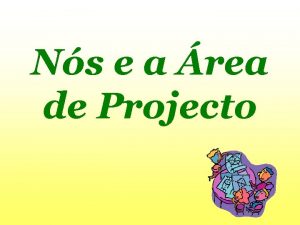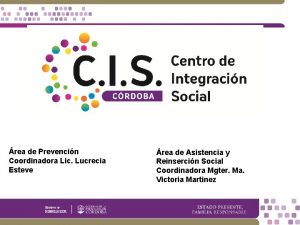The REA Model The REA Model The REA
































- Slides: 32

The REA Model

The REA Model The REA model provides structure for developing an accounting database • It helps to identify • It helps to

Types of Entities What is an entity? Three distinct types: 1 RESOURCES 2 EVENTS 3 AGENTS

RESOURCES • Resources have economic value to the organization. • What are some examples? AGENTS • Agents are the people and organizations • What are some examples?

EVENTS • Events are the business activities • What are some examples?

Developing an REA Diagram Four steps: 1. Identify the pair of events 2. Identify the resources affected by each event and the agents 3. Analyze each economic exchange event to determine whether it should be decomposed 4. Determine the cardinalities of each relationship.

Basic REA Diagram Resource A Inflow GET Resource A Participant Internal Agent External Agent Economic Duality Resource B Outflow GIVE Resource B Participant External Agent Participant Internal Agent

Step 1: Identify Economic Exchange Events • Useful to divide the paper into three columns • Left column should be used for resources. • Middle column should be used for events. • Right column should be used for agents.

• The basic economic exchange in the revenue cycle • Draw sales and cash receipts events entities as rectangles • Relationship between them as a diamond.

Step 2: Identify Resources and Agents • The sales event involves the disposal of the resource • The cash receipts event involves the acquisition of the resource

• Identify the agents who participate in those events. • There will always be at least one internal agent • And in most cases, an external agent

Step 3: Include Commitment Events • Can each economic exchange event be decomposed into a combination of one or more commitment exchange events. • • Example: • The sales event may be decomposed into the “take order” • And “deliver order”

Decomposing Sales into Orders and Sales Customer Orders Inventory. Orders Participant Customer Participant Inventory. Sales Leads to Salesperson Participant Sales Participant Customer

Step 4: Determining Cardinalities • Cardinalities indicate • • Expressed as a pair of numbers. • First number • Second number • •

Minimum Cardinality • The minimum cardinality of a relationship • • Minimum cardinalities can be either 0 or 1. A minimum cardinality of zero • A minimum cardinality of 1

• The minimum cardinality of zero in the (0, N) cardinality pair Sales (0, N) Customer

• • The minimum cardinality of of 11 in in the (1, 1) 1) cardinality pair Sales (0, N) (1, 1) Customer

Maximum Cardinality The maximum cardinality of a relationship Maximum cardinalities can be either 1 or N. A minimum cardinality of 1 A maximum cardinality of N

• The maximum cardinality of N in the (0, N) cardinality pair Sales (0, N) Customer

• The maximum cardinality of 1 in the (1, 1) cardinality pair Sales (0, N) (1, 1) Customer • Cardinalities are not arbitrarily chosen by the database designer.

Relationships between Entities • 1. 2. 3. Three basic types of relationships A one-to-one relationship (1: 1) A one-to-many relationship (1: N) A many-to-many relationship (M: N)

A one-to-one relationship Sales 1 1 Cash Receipts

A one-to-many relationship Sales N 1 Cash Receipts

A one-to-many relationship Example 2 Sales 1 N Cash Receipts

A many-to-many relationship M Sales N Cash Receipts

ER Diagrams using the REA Model • An Entity-Relationship (E-R) diagram is a common method for portraying a database schema. An E-R diagram shows • Entities are represented by • Relationships between entities •

Sample ERD using the REA Model (1, N) Inventory. Purchases (0, N) (1, 1) Participant Buyer (Purchasing Agent) (0, N) (1, N) Participant (1, 1) Vendor P/D (0, N) Participant (1, 1) (0, N) (1, 1) Cash (0, N) Stockflow Cash (0, N) Disburseme nt Participant (1, 1) Cashier

Implementing the REA Diagram • An REA diagram can be used to design a wellstructured relational database. • Create the schema from the REA diagram. • What is a well designed relational database?

Implementing the REA Diagram, continued • Implementing an REA diagram in a relational database is a three-step process: • Create a table • Assign attributes to appropriate tables Use foreign keys to implement •

The REA Model (1, N) Inventory. Purchases (0, N) (1, 1) Participant Buyer (Purchasing Agent) (0, N) (1, N) Participant (1, 1) Vendor P/D (0, N) Participant (1, 1) (0, N) (1, 1) Cash (0, N) Stockflow Cash (0, N) Disburseme nt Participant (1, 1) Cashier

Create the Tables • From the previously discussed REA diagram, nine tables would be created Assign Attributes • Primary keys: • Other Attributes:

Implement the 1: 1 and 1: M Relationships • FOREIGN KEYS • One-to-One Relationships: • One-to-Many Relationships: • The primary key of the entity with the maximum cardinality of N becomes a foreign key in the entity with a maximum cardinality of 1
 Actus reus and mens rea
Actus reus and mens rea Rea diagram cardinalities explained
Rea diagram cardinalities explained Rea model
Rea model Rea data model
Rea data model Rea model
Rea model Rea model
Rea model Rea
Rea Rea data model
Rea data model Rea diagram revenue cycle example
Rea diagram revenue cycle example Hình ảnh bộ gõ cơ thể búng tay
Hình ảnh bộ gõ cơ thể búng tay Lp html
Lp html Bổ thể
Bổ thể Tỉ lệ cơ thể trẻ em
Tỉ lệ cơ thể trẻ em Chó sói
Chó sói Thang điểm glasgow
Thang điểm glasgow Hát lên người ơi
Hát lên người ơi Các môn thể thao bắt đầu bằng tiếng chạy
Các môn thể thao bắt đầu bằng tiếng chạy Thế nào là hệ số cao nhất
Thế nào là hệ số cao nhất Các châu lục và đại dương trên thế giới
Các châu lục và đại dương trên thế giới Cong thức tính động năng
Cong thức tính động năng Trời xanh đây là của chúng ta thể thơ
Trời xanh đây là của chúng ta thể thơ Mật thư anh em như thể tay chân
Mật thư anh em như thể tay chân Làm thế nào để 102-1=99
Làm thế nào để 102-1=99 độ dài liên kết
độ dài liên kết Các châu lục và đại dương trên thế giới
Các châu lục và đại dương trên thế giới Thơ thất ngôn tứ tuyệt đường luật
Thơ thất ngôn tứ tuyệt đường luật Quá trình desamine hóa có thể tạo ra
Quá trình desamine hóa có thể tạo ra Một số thể thơ truyền thống
Một số thể thơ truyền thống Cái miệng nó xinh thế
Cái miệng nó xinh thế Vẽ hình chiếu vuông góc của vật thể sau
Vẽ hình chiếu vuông góc của vật thể sau Biện pháp chống mỏi cơ
Biện pháp chống mỏi cơ đặc điểm cơ thể của người tối cổ
đặc điểm cơ thể của người tối cổ V cc cc
V cc cc

